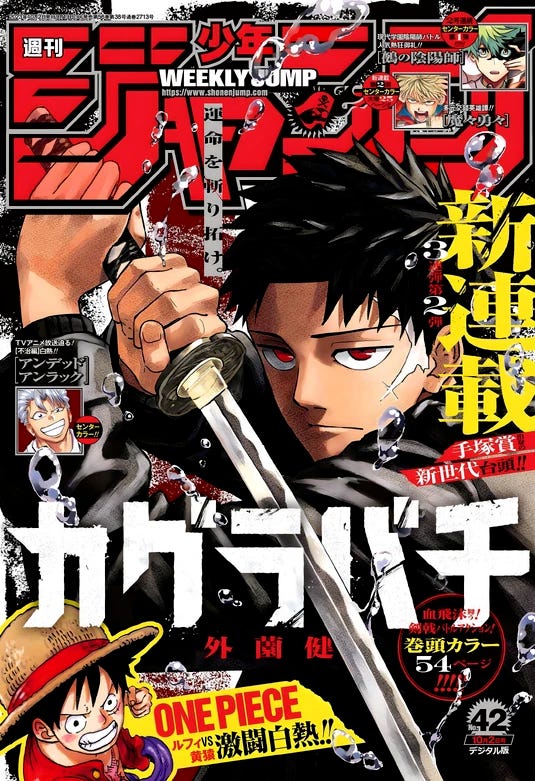Inside the manga hit machine
How Weekly Shonen Jump became a global cultural juggernaut
Manga is big business around the globe, and Shueisha’s Weekly Shonen Jump is Japan’s top manga anthology magazine. This isn’t hyperbole. In 2024, six out of the ten top-grossing manga and anime series originated in the pages of Jump. Despite this, very little has been written about how the magazine seems to have cracked the code for making content with planetary pull. Part of this is due to the secretive nature of Japanese content-production companies; part is due to linguistic and cultural barriers.
I wanted to change that. I spent the better part of a year convincing Jump’s editors to let me take a look behind the curtain, and months more reporting and writing. I embedded with the rising manga star Takeru Hokazono, creator of the hit series “Kagurabachi,” and his editor Takuro Imamura, spending time at the studio and in the offices for editorial meetings. The result became a feature in The New Yorker, which you can read here!
Their story is the story of Jump in miniature: a true intersection of art and commerce, with young creators throwing themselves into a whirlwind of tight schedules, hard creative decisions, strategic collaborations — and should their series prove truly popular, great fame and fortune. To be a manga artist in Japan is to be a kind of rock star, minus, perhaps, the sex, drugs, and rock and roll. There’s no time for that — the next deadline is coming up!
Shonen Jump specializes in shonen manga: comics for boys. A great many, “Kagurabachi” included, feature heroic protagonists with exotic abilities, making them a kind of analogue to American superhero comics. There are crucial differences, however, both in style and in execution. American comic book companies like Marvel and DC Comics own their characters outright. They outsource the development of new stories to freelance artists who work for hire. Jump creators retain ownership of their creations, so they share in the riches if their series strikes it big. Also unlike American comics, many of which are long-established franchises, Jump gives its artists wide leeway to take stories in whatever directions they see fit – so long as they keep readers engaged.
That last bit is crucial. It’s also one key to Weekly Shonen Jump’s success: it is exquisitely tuned to feedback from its fans. Prize giveaways encourage readers to fill out paper and online surveys every week, ranking their favorite titles, characters, and storylines. The responses are collated by editors and fed back to the artists, letting those so inclined use it to guide their creative decisions. It resembles the “big data” that guides the curation of content online, but leaves the ultimate decisions in the hands of the editors, who trust the creators, rather than delegating them to faceless algorithms. It’s the best of both worlds, harnessing real-time analytics while preventing the onslaught of AI-style slop. “We're not data analysts crunching numbers,” Jump’s editor-in-chief declared at a panel discussion at AnimeNYC last weekend.
But I think Jump’s biggest asset is that it is one of the most exquisitely tuned talent-finders the world has ever seen. As you’ll read in my essay, there aren’t simply a lot of people reading manga in Japan: there are a lot of them making, and aspiring to make them, too. Jump ships over a million paper copies a week, while millons more read it online. This is a huge pool of potential talent, and the mangazine uses biannual contests to solicit new manga ideas from them. The contests give the magazine a participatory feel, and the editors a chance to find diamonds in the rough.
Through them (and other methods of soliciting submissions), editors have discovered and developed some of the nation’s biggest hits, including “Dragon Ball,” “Naruto,” “Yu-Gi-Oh!,” “One Piece,” and “Demon Slayer,” just to name a few. These series continue to generate hundreds of billions of dollars in revenue. More interestingly, by winning hearts and minds around the globe, they have greatly contributed to Japan’s rise as a fantasy superpower — and one of the planet’s most popular tourist destinations. Actually, we’re beyond “popular” here. This is the kind of influence that shifts a nation’s fortunes.
So the manga published in Shonen Jump’s pages more than just compelling fantasies: they are blueprints for personal fortunes, multimedia empires, and soft power. We’ve all heard about Japan’s “gross national cool,” but I think Japan has taken this a step further — it has created a “fantasy-industrial complex.” And Weekly Shonen Jump is one of its cornerstones.
Jump is a dream factory for both the artists who compete in its pages for mindshare, and for readers all over the world who lose themselves, and find themselves, in its pages. As hit Jump series like “My Hero Academia” and “Jujutsu Kaisen” wind down, the magazine is hungry to find its next global hit. Will it be “Kagurabachi”? Its creators certainly hope so. It’s a story with as much adventure as any manga — read the essay here!




This was a great read, thanks for sharing!